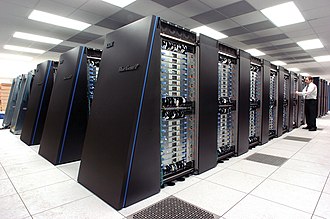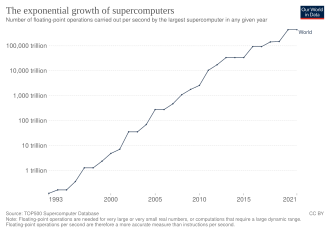
Supercomputer
Type of extremely powerful computer / From Wikipedia, the free encyclopedia
Dear Wikiwand AI, let's keep it short by simply answering these key questions:
Can you list the top facts and stats about Supercomputers?
Summarize this article for a 10 years old
A supercomputer is a computer with a high level of performance as compared to a general-purpose computer. The performance of a supercomputer is commonly measured in floating-point operations per second (FLOPS) instead of million instructions per second (MIPS). Since 2017, there have existed supercomputers which can perform over 1017 FLOPS (a hundred quadrillion FLOPS, 100 petaFLOPS or 100 PFLOPS).[3] For comparison, a desktop computer has performance in the range of hundreds of gigaFLOPS (1011) to tens of teraFLOPS (1013).[4][5] Since November 2017, all of the world's fastest 500 supercomputers run on Linux-based operating systems.[6] Additional research is being conducted in the United States, the European Union, Taiwan, Japan, and China to build faster, more powerful and technologically superior exascale supercomputers.[7]


Supercomputers play an important role in the field of computational science, and are used for a wide range of computationally intensive tasks in various fields, including quantum mechanics, weather forecasting, climate research, oil and gas exploration, molecular modeling (computing the structures and properties of chemical compounds, biological macromolecules, polymers, and crystals), and physical simulations (such as simulations of the early moments of the universe, airplane and spacecraft aerodynamics, the detonation of nuclear weapons, and nuclear fusion). They have been essential in the field of cryptanalysis.[8]
Supercomputers were introduced in the 1960s, and for several decades the fastest was made by Seymour Cray at Control Data Corporation (CDC), Cray Research and subsequent companies bearing his name or monogram. The first such machines were highly tuned conventional designs that ran more quickly than their more general-purpose contemporaries. Through the decade, increasing amounts of parallelism were added, with one to four processors being typical. In the 1970s, vector processors operating on large arrays of data came to dominate. A notable example is the highly successful Cray-1 of 1976. Vector computers remained the dominant design into the 1990s. From then until today, massively parallel supercomputers with tens of thousands of off-the-shelf processors became the norm.[9][10]
The US has long been the leader in the supercomputer field, first through Cray's almost uninterrupted dominance of the field, and later through a variety of technology companies. Japan made major strides in the field in the 1980s and 90s, with China becoming increasingly active in the field. As of May 2022, the fastest supercomputer on the TOP500 supercomputer list is Frontier, in the US, with a LINPACK benchmark score of 1.102 ExaFlop/s, followed by Fugaku.[11] The US has five of the top 10; China has two; Japan, Finland, and France have one each.[12] In June 2018, all combined supercomputers on the TOP500 list broke the 1 exaFLOPS mark.[13]